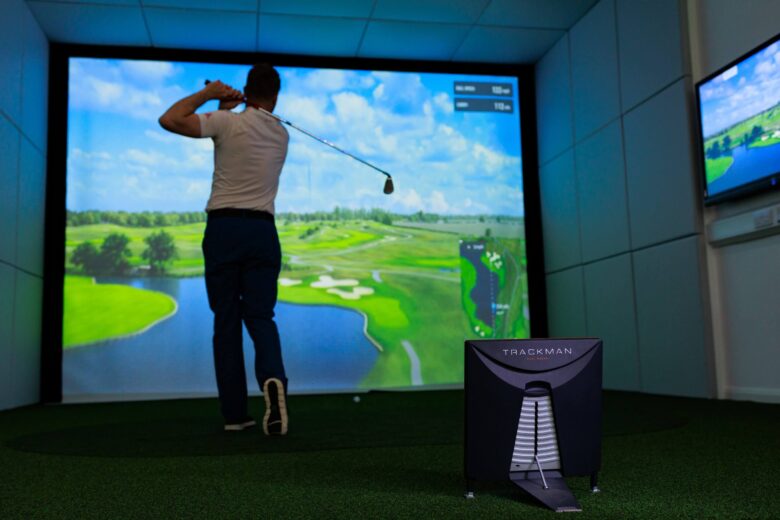Golf simulators have been steadily gaining popularity in recent years, transforming the way golfers practice, play, and enjoy the sport. These advanced systems offer a virtual golfing experience, allowing players to enjoy the game indoors and at their convenience. As technology continues to evolve, simulators are becoming more realistic, accurate, and immersive, revolutionizing the sport and the industry as a whole.
Contents
- The Evolution of Golf Simulator Technology
- AdvantagesTraditional Golfing
- Improving Accessibility: Making Golf a Sport for All
- Customizable Experiences: Tailored to Individual Needs
- Enhancing Training and Performance with Data Analytics
- Expanding the Social Aspect: Virtual Tournaments and Community Building
- Eco-Friendly Golfing: Reducing the Environmental Footprint of the Sport
- Future Prospects: The Growing Role of Virtual Reality and Augmented Reality
- Final Thoughts: Embracing the Future
The Evolution of Golf Simulator Technology
Simulators have come a long way since their inception in the 1970s. Early systems provided a basic representation of the golf course and rudimentary swing analysis. However, technological advancements have led to a rapid evolution in simulator capabilities. Today, they are equipped with high-resolution screens, 3D graphics, and advanced sensors that accurately measure various aspects of a golfer’s swing, such as club speed, ball speed, and launch angle.
Moreover, modern devices at 247.golf integrate with advanced software that provides detailed analytics and feedback, helping players refine their technique and improve their performance. Some systems even offer the option to simulate real-world golf courses, allowing players to experience and practice on famous courses from around the globe.

Source: forbes.com
AdvantagesTraditional Golfing
They provide several advantages over traditional golfing that contribute to their growing popularity. Firstly, they offer year-round access to the sport, regardless of weather conditions. This allows golfers to maintain and improve their skills even during the off-season or in regions with inclement weather.
Secondly, simulators provide instant feedback and analytics, which can significantly improve a golfer’s understanding of their swing and overall performance. This data-driven approach accelerates the learning process and helps golfers make more informed decisions about their technique and equipment.
Additionally, simulators save time by eliminating the need to walk between shots and wait for other players. This convenience factor makes it possible for busy individuals to squeeze in a quick practice session or a round of golf during their lunch break or after work.
Improving Accessibility: Making Golf a Sport for All
One of the most significant impacts of simulators is their ability to make the sport more accessible to a wider audience. Traditional golf can be expensive, with high membership fees, equipment costs, and limited availability of courses, particularly in urban areas. Simulators provide an affordable and convenient alternative, allowing more people to enjoy the sport without breaking the bank.
Furthermore, simulators are less intimidating for beginners, as they can practice in a private, judgment-free environment. This makes it easier for new players to learn the basics and build their confidence before stepping onto a real course.
These devices also provide an opportunity for people with physical limitations or disabilities to enjoy the sport, as they can be customized to accommodate individual needs and abilities.

Source: evolvedallas.com
Customizable Experiences: Tailored to Individual Needs
These units offer a high degree of customization, enabling players to tailor their experience to their preferences and skill levels. Golfers can choose from various virtual courses, adjust weather conditions, and even simulate different types of grass or sand to practice on.
In addition, simulators allow players to adjust the difficulty level, making it possible to practice specific shots or simulate challenging course conditions. This level of customization enables golfers to focus on improving specific aspects of their game, leading to faster progress and a more enjoyable experience.
Enhancing Training and Performance with Data Analytics
Data analytics plays a crucial role in the modern simulator experience. By leveraging advanced sensor technology, simulators can collect a wealth of data on each swing, including clubhead speed, ball speed, launch angle, spin rate, and more. This information is then processed by sophisticated software to provide players with actionable insights and feedback.
Golfers can use this data to identify areas of improvement, track their progress, and make informed decisions about their equipment and technique. This data-driven approach to training not only accelerates skill development but also enables players to fine-tune their performance and achieve better results on the course.
Moreover, many simulators integrate with popular coaching platforms and apps, allowing golfers to share their data with coaches or instructors for expert guidance and personalized training plans.

Source: acousticgeometry.com
Expanding the Social Aspect: Virtual Tournaments and Community Building
These devices are not only revolutionizing the way people practice and play golf but also redefining the social aspect of the sport. Virtual tournaments and online leaderboards have become increasingly popular, allowing players from around the world to compete against each other without leaving their homes or local simulators.
These virtual events foster a sense of community and friendly competition, making the sport more engaging and enjoyable. Additionally, simulators can be a fun and interactive way for friends and family to spend time together, regardless of their skill level.
Eco-Friendly Golfing: Reducing the Environmental Footprint of the Sport
Golf simulators offer an eco-friendly alternative to traditional golfing, reducing the environmental impact of the sport. Golf courses require significant amounts of water, pesticides, and fertilizers to maintain pristine playing conditions. Additionally, the construction and maintenance of golf courses can lead to habitat loss and other environmental concerns.
By opting for simulators, players can enjoy the sport without contributing to these negative impacts. Virtual golf requires minimal resources and generates no waste, making it a more sustainable option for both players and facility operators.
Simulators can help raise awareness of environmental issues by simulating courses that highlight the importance of sustainable practices and conservation efforts.

Source: golfswingsystems.co.uk
Future Prospects: The Growing Role of Virtual Reality and Augmented Reality
As technology continues to advance, virtual reality (VR) and augmented reality (AR) are expected to play an increasingly prominent role in simulators. These immersive technologies have the potential to further enhance the realism and interactivity of virtual golf experiences.
VR headsets could provide an even more immersive experience, allowing golfers to feel as if they are truly on the course. Meanwhile, AR technology could overlay virtual elements onto the real world, creating a seamless blend of physical and digital golf experiences.
These cutting-edge technologies have the potential to further revolutionize the simulator industry and attract new audiences to the sport. As the lines between the virtual and real worlds continue to blur, golfers can expect more innovative and immersive experiences, pushing the boundaries of what is possible within the realm of simulation.
Final Thoughts: Embracing the Future
In conclusion, simulators are undeniably reshaping the golf industry, offering an array of benefits to players, coaches, and businesses alike. From improving accessibility and reducing the sport’s environmental impact to enhancing training with data analytics and expanding the social aspects of golf, simulators are revolutionizing the way people experience and engage with the sport.
